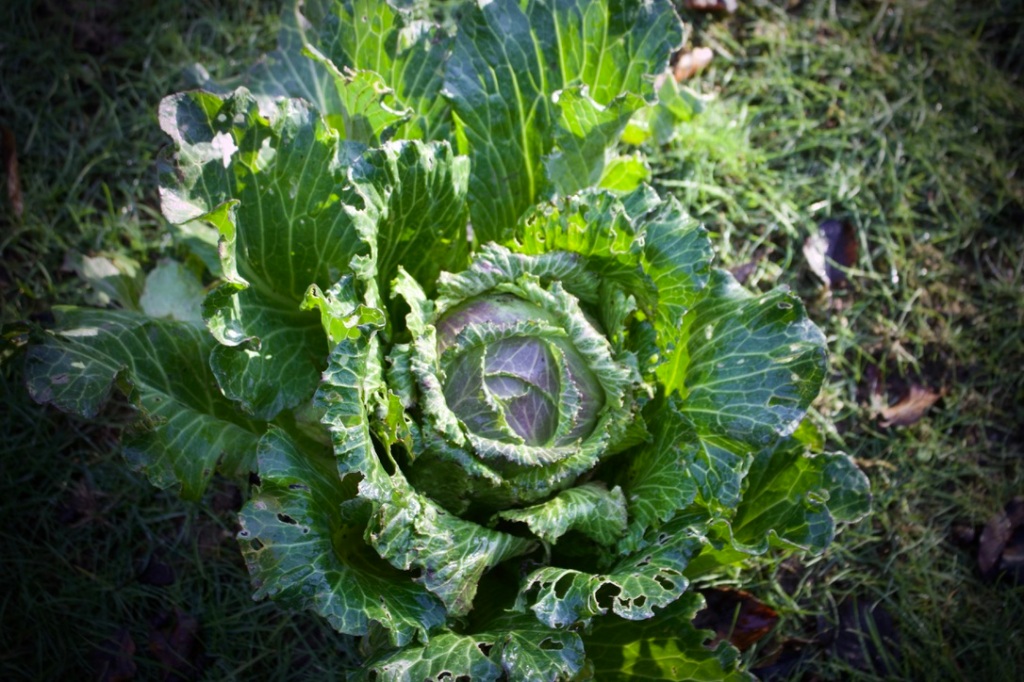It’s frosty outside but there is still one stalwart of the kitchen garden producing and that is the cabbage January King. The king of winter cabbages is actually a French variety called “chou de Milan de Pontoise” and has been grown since 1865 in the UK. However the name January King really suits this variety. Whilst most cabbages grown now are F1 hybrids, this one survives as nothing can outlast it in a bad winter. Therefore even after all these years it holds the RHS award of garden merit at the time of publishing.

In the kitchen
January King is a savoy cross so is only slightly crinkly. It is best lightly steamed or cooked with a knob of butter and a little water. To ring the changes try adding some fennel or cumin seeds. If you fancy being a bit more adventurous try substituting for the kale in Bhajias.
Once harvested January king will store in a cool place for several weeks with no issue.
Yield and plant health
January King comes in to its own in the winter kitchen. It is one of the most hardy cabbages that can be grown and can survive and even thrive in a cold winter which would kill off other winter cabbages. It is a small drum head so has slightly lower yields than more modern varieties but will happily serve four people or more. I have never known it to bolt. It is susceptible to cub root and like all brassicas, pigeons, cabbage white butterflies and cabbage root fly.

Suppliers
Very widely available but can also be found at

Growing
An organised cabbage grower with plenty of space can supply the kitchen with cabbage all year round in the UK. Varieties of cabbage can be split in to harvest time, spring, summer, autumn and winter. They can also be further subdivided by colour (purple, white or green), leaf type (savoys which are crinkled or smooth) and head type (drumhead forming produce tight balls, collard produce plentiful loose leaves which can be harvested leaf by leaf as required). Chinese cabbages like Pak Choy, Napa and Choy Sum are also varieties of cabbage, usually treated as a summer or autumn cabbage in the UK. Napa cabbage is the variety to use for kimchi. Red cabbage are traditionally grown as autumn cabbage and will store for a long time in a cool place, they are also traditionally used for picking. White drumheads are traditionally used for sauerkraut but you can also use red.
The type of cabbage seed you buy will determine what time you start sowing.
Summer cabbages are sown in February to early March, planted in their final positions in May and harvested in July – October.
Autumns cabbage are sown March – June, transplanted May-June and harvested August to November. They are usually not hardy enough to stand severe winter frosts.
Winter cabbages are sown in April to May and planted in final positions in June to July. They are the most hardy and can be harvested in November to March. Winter cabbages can last a long time when harvested if stored in a cool place like a garage or fridge.
Spring cabbages are sown in June to July and planted out in September to October and harvested March to May. Often spring cabbages may also be used as summer cabbages too.

You can start cabbages in pots in a green house or outdoors. Sow 1cm deep. In pots sow 1-3 seeds in a 3 inch pot. Outdoors sow thinly in rows 15cm apart. Thin seedlings to one every 7cm or 1 per 3 inch pot. Water lightly until it is time to plant out. Early outdoor sowings in February and march will benefit from a cold frame or fleece covering.
Once the plants have several true leaves plant out in final positions. Cabbage are not too fussy about sunlight but they do need a firm soil so you might struggle with a very sandy soil. They will appreciate a feed of blood fish and bone or another organic fertiliser in the spring and a mulch to conserve water. Commonly growers would sprinkle a little lime on the soil before planting as this helps to avoid club root but also cabbage like an alkaline soil. If you want to do this though do it sparingly and follow manufacturing guidelines. Calcified seaweed and ground chalk are preferable to organic growers. Always wear a face mask and gloves when sprinkling lime and follow manufacturing instructions.
Pot grown plants will need a period of a week being moved outdoors during the day and brought inside at night to harden off. Plant 40 – 50 cm apart, firming in strongly to stop the plants rocking in high winds. Water in well and make sure that they are well watered until established. After this water only if it has been dry for several weeks.
Brassicas can fall victim to cabbage white butterfly or birds. Grow under butterfly netting to avoid this, making sure the netting does not touch the cabbage.
There are two major issues that can affect cabbages, cub root and cabbage root fly.
Cub root is a fungal infection that affects grown. Roots will look swollen and distorted and cabbages will fail to thrive. Once on your plot you should not grow cabbage there for up to 20 years. If that is not possible then there are resistant varieties. Raising the PH of the soil with lime also helps.
Cabbage root fly burrow in to the roots of the cabbage and the cabbage slowly wilts and dies. If you pull up the plant then you will see maggots on the roots. You can buy little collars that go around the base of the cabbage which stops the fly laying her eggs on the roots.

Alternatives
Kale Cavolo Nero
One Comment Add yours